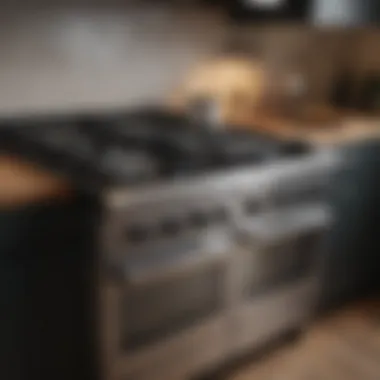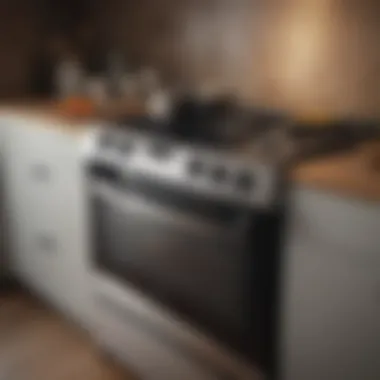Ultimate Guide to Effectively Cleaning Your Cooker


Intro
Cleaning your cooker is not just about maintaining its appearance; it profoundly impacts its performance and longevity. Over time, cookers accumulate grease, food residue, and grime, which can lead healthy cooking and heat distribution hazards. Moreover, a regularly cleaned stove minimizes the risks of fires while ensuring sanitary conditions for food preparation. This guide aims to provide readers with a systematic approach to keeping various types of cookers clean and functioning optimally.
Understanding Your Cooker Type
Before diving into the cleaning process, it is critical to recognize that different cookers come with distinct cleaning needs.
- Gas Cookers: They often require attention to burners and grates, where food may become trapped.
- Electric Cookers: These need careful handling to avoid damaging electrical components while cleaning.
- Induction Cookers: The surface is usually smooth but can easily demonstrate marks, calling for specific cleaning methods.
Each type poses its challenges but rewards effort with enhanced efficiency and aesthetics.
Essential Cleaning Tools and Solutions
To undertake this task adequately, gather essential cleaning tools and solutions, which may include:
- Liquid dish soap
- Baking soda
- Vinegar
- Soft cloths or sponges
- Abcron pads designed for specific surfaces
/ An array of effective cleaners and maintenance tools allows deeper cleaning and assists in eliminating hardened stains effectively.
Choosing the right options will ensure effective results without harming the surfaces. Maintain a balance betweenabrasive and gentle materials to safeguard the cooker while still achieving cleanliness.
Regular Cleaning Techniques For Different Cookers
The cornerstone of cooker maintenance is regular cleaning practices.
Gas Cookers
- Remove burner grates: Soak them in hot soapy water them scrub gently before rinsing.
- Clean burners: Wipe down the burners with a cloth soaked in diluted vinegar.
- Check ignition paths: Use a pin to clear any obstructions which could interfere with gas flow.
Electric Cookers
- Unplug the device: Always ensure that it is powered off to avoid any electrical issues.
- Use damp cloth: Wipe down the stovetop using a cloth dampened with soapy water or vinegar.
- Clean coil burners carefully: Give attention to any debris that may affect the efficiency and determine if replacement is necessary.
Induction Cookers
- Wipe with a specific cleaner: This helps maintain its sleek surface without scratching it.
- Avoid sharp objects: Gently removing food spills is key to prevent scratches.
Adhering to a cleaning schedule based on usage will significantly enhance the lifespan and functionality of any cooker.
End
In this guide, I have provided you with the foundation for effective cooker maintenance through comprehension of different types of cookers as well as the most pertinent cleaning solutions and techniques. Regular upkeep keeps your cooking environment healthy and boosts performance. Thorough cleaning, armed with the right tools, can forever change your culinary experience at home.
Foreword to Cooker Cleaning
Cleaning a cooker plays a crucial role in maintaining an efficient and hygienic kitchen. This section will delve into the importance of regularly cleaning various types of cookers, along with their associated benefits. As homeowners dedicate significant time and resources to cooking, it is essential to ensure that these appliances operate effectively by making cleaning a priority.
Understanding the Importance of Cleaning
The accumulation of grease, food debris, and residue in cookers can result in inefficient heating and unpleasant odors. Regular cleaning minimizes health risks, as unclean appliances may harbor harmful bacteria that can contaminate food. Regular cooker cleaning enhances the lifespan of the appliance, preserving its performance and reducing potential repair costs over time. Maintaining cleanliness also ensures consistent cooking results, allowing food to taste as intended. The aesthetic aspect should not be overlooked; a clean cooker improves the overall appeal of the kitchen. Routine cleaning can instate a trustworthiness in guests when they observe caring details in domestic environments.
Types of Cookers and Their Cleaning Needs
Different kinds of cookers require diverse approaches to cleaning as their design and function differ significantly. To properly address these appliances, it is important to explore each type in depth.
Gas Cookers
Gas cookers, known for their responsive heat settings, are a popular choice among cooking enthusiasts. The key characteristic of gas cookers is the immediate heat alteration achieved by igniting the gas flame. While they provide excellent control over cooking temperatures, they also require consistent cleaning to mitigate the risks of clogging in their burners.
A unique feature of gas cookers is their open flame functionality, offering the ability to use various cooking techniques. However, the disadvantage comes from more significant grease visibility and potential hazards that necessitate regular cleanup to avoid fumes and spills leading to fire risks.


Electric Cookers
Electric cookers utilize electric heat to cook food, making them a convenient choice for many households. A significant benefit is their automated cooking features, allowing users to set and forget meals with precision.
These cookers often come with non-stick surfaces that enhance cleanliness as food tends to release easily. However, their cleaning needs can involve addressing burnt food residues or spills around the heating elements. Unlike gas cookers, precautions against water exposure should be emphasized to preserve electrical components.
Induction Cookers
Induction cookers represent cutting-edge technology by employing magnetic fields to directly heat cookware. This key characteristic enhances energy efficiency significantly since heat is concentrated directly in the pot. The smooth, flat surface is easier to wipe down, making cleaning relatively simple.
The advantage of induction cookers includes rapid heating and the elimination of hot surfaces, reducing the likelihood of burns. On the contrary, users must ensure compatibility with ferrous cookware, which can pose cleaning challenges if mismatched items are used. Understanding each category’s specific cleaning needs sets a basis for enhancing appliance longevity and operation efficiency.
Preparation for Cleaning
Preparation for cleaning a cooker is a critical step that sets the tone for the entire cleaning process. It involves much more than merely gathering supplies; it also establishes a safe environment, optimizing the effectiveness of your cleaning efforts. Proper preparation can help avoid damage to your cooker and contribute to better results in maintaining its appearance and functionality.
Gather Necessary Tools and Supplies
Cleaning Solutions
Cleaning solutions play a vital role in the removal of grease, stains, and food residue from the cooker. Many homeowners prefer commercially formulated solutions because they are designed specifically for this purpose. A good cleaning solution breaks down stubborn stains effectively without causing harm to the surfaces of your cooker. Popular options include oven cleaners and all-purpose degreasers. While some may prefer natural alternatives, like vinegar or baking soda, these can take longer to achieve similar results clinically.
Scrubbing Pads
Scrubbing pads are essential for applying pressure while cleaning and removing baked-on stains. They come in various types, such as non-abrasive and abrasive. Non-abrasive pads are gentle and suitable for gleaming appliance finishes, while abrasive ones target tougher grime with better efficiency. Specific mixed scrubbing pads can tackle different challenges effectively. However, it's vital to select the right material to avoid scratching and damaging the cooker’s surface.
Microfiber Cloths
Microfiber cloths are excellent when it comes to polishing and wiping down the cooker. Unlike traditional cloths, microfiber does not make use of harsh chemicals and effectively traps dust. They are especially popular for their durability and reuse potential. Polyamides and polyesters combine to give them an edge as effective cleaners. However, they must be used properly to yield the best results.
Ensure Safety Measures
Before starting any cleaning routine, it is essential to ensure your safety. This safety protocol protects both the individual cleaning and the equipment being cleaned. If appropriate precautions are taken, the risk of accidents or damage can diminish.
Powering Down Electric Cookers
Powering down electric cookers is crucial for safety. Disconnecting the appliance protects you from any electrical hazards during the cleaning process. This is especially relevant given that appliances that have recently been in use may retain heat or electrical charge. Furthermore, taking this step allows you to tackle all cleaning areas without stress.
Allowing Gas Cookers to Cool
Allowing gas cookers to cool after use is another critical safety measure. It is not advisable to clean these appliances immediately after cooking. Cooking surfaces can remain hot enough to cause burns. Beyond comfort, performing cleaning activities on cooled surfaces often makes the cleaning process easier. Residues soften when cooled, enabling straightforward removal.
By prioritizing preparation and safety, you set a strong foundation for a successful cleaning process. Taking time at this stage might seem tedious, but it pays off significantly with cleaner and safer cookers.
Step-by-Step Cleaning Process
Cleaning your cooker is not merely a chore; it’s an essential practice for maintaining hygiene and efficiency in your kitchen. A systematic approach aids in removing grime and ensures all surfaces are well-maintained. Following a step-by-step process can lead to better results, saving both time and effort in the long run. An organized cleaning routine also helps to prevent issues down the line that could arise from neglect.
Cleaning the Exterior
The exterior occasionally shows more wear than the interior, so keeping it clean is crucial. A sparkling outside not only reflects your cooking habits but also preserves the condition of the cooker.
Wiping Down Surfaces
Wiping down surfaces may seem straightforward, but it has a significant role in overall cooker cleanliness. Regular cleansing prevents the accumulation of grease and dust, which can lead to tarnishing and permanent stains. People find it helpful because this action leaves all visible areas looking neat and presentable. This lends an inviting ambiance to your culinary space.
The key characteristic of wiping down surfaces lies in its ability to short-circuit potential long-term damage. An effective choice involves using a suitable cleaner that does not leave residues. One unique feature that warrants attention is the use of microfiber cloths, as they trap dust and allergens effectively. Their main advantages include being very efficient in cleaning without scratching the surface. However, a disadvantage might be their need for frequent washing to remove trapped grime efficiently.
Cleaning Knobs and Control Panels
Cleaning knobs and control panels is just as important as the surface polishing. These parts are frequently touched and can become unsightly quickly due to grease or fingerprints. Regular cleaning improves both functionality and aesthetics, ensuring no residues affect performance.


This is a beneficial habit since neglecting these areas can lead to a poor user experience. The main advantage of maintaining a clean control panel is that it provides clarity when selecting functions, enhancing ease of use. A distinct feature to consider is that, unlike typical surfaces, these pieces may require gentle handling to avoid breaking small components. Many believe that using non-abrasive sponges or cloths protects these surfaces, while harsh chemicals may peel off specific coatings, leading to visual aging.
Cleaning the Interior
A clean interior is vital for efficient heat distribution and prolongs the life of the cooker. Unclean interiors can harbor bacteria, lead to bad odors, and promote malfunctions.
Removing and Cleaning Oven Racks
Removing and cleaning oven racks is a task often avoided. However, it significantly enhances oven hygiene. This step prevents built-up food debris from affecting other meals cooked subsequently. Regular attention helps remove accumulated grease in hard-to-reach places.
The racks contain many surface areas, making them popular choices for cleaning tasks. Notably, a major advantage comes directly from removing the racks. It allows for an overall deeper cleaning since individual crevices can be treated without hindrance. Their unique feature is that they are typically removable, putting less strain on your effort, but one downside is their heaviness, which may cause some difficulty when hoisting out.
Wiping the Inside Walls and Bottom
Wiping the inside walls and bottom is essential in keeping optimal air circulation in the cooker. Hot temperature cooking without frequent interior wipes results in collection of toxins. Properly wiping these sections mitigates both health risks and unpleasant smells.
This operation becomes a beneficial practice for sustaining the cooker’s integrity. It yields clear advantages, such as marginally improving temperature regulation. Wiping settles accumulated grease residues to stave off long-term damage, while the unique aspect lies in that cleaners can vary in concentration, ranging from lemon-juice diluted mixtures to store-made vegetables-safe cleaning solutions.
Cleaning Specific Components
Focusing on cleaning specific components of the cooker is crucial. Thorough attention to distinct areas can yield richer oven performance and contribute to a cleaner kitchen environment.
Maintaining Burners on Gas Cookers
Maintaining burners on gas cookers is an often-overlooked, yet extremely impactful, aspect of cooking hygiene. Regular upkeep generally involves cleaning various ports while devising methods is rather straightforward. Well-maintained burners can significantly improve energy usage and correct functionality for cooking great meals.
One key characteristic that many appreciate is the ease of access during the cleaning routine, fostering proper visibility to examine any debris. This regular examination helps identify any blocking elements that may cause uneven flame patterns. One disadvantage might be the hefty undertaking involved, as proper cleaning can sometimes be tedious.
Cleaning Induction Plates
Cleaning induction plates deserves noteworthy mention due to their sleek design and enhanced feasibility. These surfaces can retain residue from both past cooking experiences and splatters that occur naturally in kitchens. Such surfaces are beneficial as they often promote uniform heat while avoiding much smoke and grease hazard.
A unique feature of cleaning induction plates is that they require minimal effort, often merely needing a damp cloth for upkeep. The main advantage lies in the ease of care inherently built into induction surfaces. Although they easily attract fingerprints, ensuring frequent cleaning can outweigh such disadvantages overall. Practicing timely cleaning routines guarantees an inviting cook surface with reduced long-term issues.
Troubleshooting Common Issues
Cleaning a cooker is not just about regular maintenance; it also involves understanding and resolving common problems that may arise due to neglect or improper care. These challenges can diminish the performance and aesthetic of your cooker. Therefore, being equipped with knowledge on how to address these issues is essential for both effective cleaning and the prolonged life of the appliance. This section focuses on persistent stains and grease, as well as odors that can emanate from your cooker, providing practical solutions for homeowners.
Persistent Stains and Grease
Persistent stains present a challenge in any cleaning routine. Over time, grease and food residues can accumulate, leaving dark marks that are difficult to remove. Successful management of these stains is key to maintaining both hygiene and the visual appeal of your cooker.
To tackle these residues, consider the following approaches:
- Use a Degreaser: Apply a targeted degreasing solution on the stained areas. Look for products designed for kitchen use, or create an effective mixture using vinegar and baking soda. This can penetrate the grease and aids in lifting it from the surface.
- Scrubbing Pads: Use non-abrasive scrubbing pads to carefully scour the area. Avoid harsh materials that could scratch surfaces. Gently work your way across the staine to avoid spreading it.
- Heat Application: Heat up the cooker slightly before application of cleaning solution. A warm surface can sometimes facilitate easier removal of greases and bio-films that are otherwise stuck.
Try to act quickly if spills or splatters occur. The sooner you address stains, the more easily they can be eliminated.
Odors from the Cooker
Unpleasant odors from a cooker can stem from poorly cleaned surfaces or spills that have burned into the surface. These odors can linger, impacting the kitchen environment and even affecting the taste of food being prepared. Understanding the origin of smells can be useful in selecting the right method of removal.
To mitigate unwanted odors, keep these tips in mind:
- Regularly Clean the Surface: Regular thorough cleaning prevents the buildup of food particles that can emit odors when heated. Pay special attention to hard-to-reach corners.
- Use Vinegar and Water Solution: For musty or burnt odors, a mixture of vinegar and water can neutralize smells. Spray it on surfaces, let it sit for a few minutes, and wipe down with a cloth. This can absorb and mitigate thick smells.
- Baking Soda: Place an open container of baking soda inside the cooker overnight after cleaning. It helps in absorbing lingering odors. The purchased airs need time to absorb and can be effective without any additional effort.
Regular maintenance not only keeps your cooker in excellent working condition but also helps in preventing odors from forming in the first place. Implementing even simple routines can bring significant benefits to your cooking environment.
Preventative Maintenance
Preventative maintenance is a proactive approach to a lengthy and hassle-free using your cooker. By engaging in routine upkeep, you prevent build-up of grime, grease, and food debris. Moreover, consistent cleaning can extend the lifespan of your cooker. A sophisticated understanding of preventative maintenance decreases the risk of significant repairs in the future.


Benefits of Preventative Maintenance:
- Sustained Performance: Regular checks ensure that all components of your cooker operate effectively, thus preserving its efficiency.
- Health Safety: A clean cooker contributes to a healthier cooking environment. This minimizes potential contamination from bacteria or other harmful substances.
- Cost-Effectiveness: Maintaining your cooker helps avoid costly fixes in the long run. Repairs can add up quickly if issues are not detected early.
Establishing a Regular Cleaning Schedule
A well-thought-out cleaning schedule enables you to manage cleaning tasks efficiently. Consider setting weekly or monthly practices. Frequently cleaning high-contact areas is prudent. Daily tasks may include wiping down surfaces and knobs, whereas deeper cleaning should occur once or twice a month.
Suggested Cleaning Frequency:
- Daily: Wipe down counters and smart touch control panels to keep them free from residue.
- Weekly: Clean interior and exterior surfaces with appropriate solutions to prevent build-up.
- Monthly: Conduct a thorough cleaning, include burners and induction plates in the process.
Best Practices for Cooker Care
Effective cooker care goes beyond simple cleaning. Proper usage and maintenance reduces wear and enhances functionality.
- Use Suitable Cleaning Products: Avoid harsh chemicals that can harm surfaces. Look for non-toxic solutions that provide effective cleaning without corrosion or damage.
- Check Appliance Conditions: Keep a check on hoses, lobes, knobs, and gas connections to ensure they perform properly.
- Address Ranch Pending Later: If cleaning reveals a pending issue, address it promptly to ensure optimal functioning over time.
Consider adopting these practices as an ingrained part of your cooking routine to enjoy your cooker longer.
Preventative maintenance pays significant dividends in long-term appliance health and safety. The small efforts you make now can foster a cleaner, more efficient kitchen environment.
Expert Tips
Cleaning a cooker is a task that often goes overlooked. However, employing expert tips can transform this chore into a more efficient and effective process. Such recommendations not only ensure the cleanliness of your appliance but also enhance its longevity and performance. Professional insights take into account common mistakes, time-saving tactics, and specialized techniques that are essential for all types of cookers. Following this section can elevate your cleaning routine from basic to proficient.
Recommendations from Professional Cleaners
Professional cleaners have invaluable experience that significantly contributes to effective cooker maintenance. Some of their recommendations include:
- Utilizing the Right Tools: Professional cleaners swear by the importance of using appropriate cleaning tools. A high-quality scraper can effectively tackle burnt-on food, while appropriate brushes can help clean burners without damaging the surface.
- Specific Cleaning Agents: Each cooker type has unique requirements. For gas cookers, they advise an all-purpose cleaner, while for induction cookers, a gentle cleaner specifically formulated for glass surfaces is ideal.
- Ventilation is Key: When cleaning, ensure good ventilation. Strong odors can emanate from cleaning solutions, and cleanliness is often compromised under poor air flow, making it even harder to dislodge soot and grease.
- Detailed Rinse is Necessary: After applying cleaning solutions, a thorough rinse with clean water can prevent residue buildup. This step decreases the scraper's need and often results in a shiny finish.
Moreover, professionals recommend allowing surfaces to dry properly before use to ensure hygiene and safety.
Using Eco-Friendly Cleaning Solutions
There is increasing recognition of eco-friendly cleaning solutions, and for good reason. Using such products has several compelling benefits:
- Healthier Home Environment: Conventional cleaning agents are often laden with harsh chemicals. Eco-friendly cleaners minimize toxic exposure, making your kitchen safer, especially for children and pets.
- Gentle on Surfaces: Natural solutions like vinegar and baking soda are effective cleaning agents. Their milder nature protects your cooker’s surfaces from unintentional damage.
- Affordability: Many eco-friendly solutions can be created using basic household ingredients. For instance, baking soda combined with water makes an effective paste for removing tough stains without expense.
- Environmental Impact: Using eco-friendly products reduces harmful impacts on the environment, aligning with the growing desire for sustainable living.
In practice, to mix your effective pork cleaner, combine equal parts of vinegar and water in a spray bottle. Apply to the surfaces, let it rest for 5-10 minutes, then wipe clean with a microfiber cloth.
“A clean cooker is not just visually pleasing but also a gatekeeper for hygienic cooking, impacting your health with each meal you prepare.”
In summary, expert tips from professionals alongside eco-friendly practices greatly enhance the process. Understanding these elements ensures that cookers not only stay clean but function optimally, serving your meals with safety and joy.
Finale
Cleaning a cooker is not just an occasional chore; it's critical for maintaining a functional and efficient kitchen. A well-maintained cooker can lead to better cooking outcomes, increase the lifespan of the appliance, and improve the overall cleanliness of your kitchen environment. Adhering to cleaning routines amplifies the importance of hygiene, thus ensuring that food is prepared in a sanitary setting.
Regularly cleaning your cooker prevents the buildup of harmful bacteria and reduces fire hazards, essential for safety in the kitchen.
In this section, we will recap the cleaning importance and encourage a routine maintenance schedule.
Recap of Cleaning Importance
Frequent cleaning of your cooker enhances functionality. A dirty cooker can alter the cooking process, leading to uneven heat distribution and enhancing the likelihood of unwanted flavors seeping into your dishes. Furthermore, buildup from grease and food remnants poses a more significant risk of potential malfunctions down the line. This not only disrupts your cooking but may also necessitate costly repairs.
Sustained cleanliness also reflects a commitment to health and well-being. By ensuring your cooker is regularly cleaned, you invest in creating a space where meals are made safely and efficiently. This conscious effort contributes positively to your lifestyle and allows for better food experiences.
Encouragement for Routine Maintenance
Implementing a routine cleaning schedule is key to cooker maintenance. Consider making this a weekly or bi-weekly task, incorporating it into your overall kitchen care routine. Setting dedicated reminders for cleaning can help you stay on track. Even a short cleaning session can yield substantial dividends in the long run.
Best practices to ensure a thorough clean include creating a checklist of tasks to complete each time you clean.
- Exterior Wipe: Regularly wipe the outer surfaces to keep them devoid of mildew or grime.
- Check Components: Inspect and tidy most parts like burnders or knobs, which can easily gather grease.
- Thorough Interior Clean: Dedicate time to remove racks and thoroughly clean the inside.
By prioritizing and valuing cleanliness, you enhance not only the functionality of your cooker but also maintain a welcoming kitchen atmosphere that is conducive to culinary activities. Establishing this routine ensures consistency in the level of cleanliness, ultimately maintaining your kitchen to its best standards.







